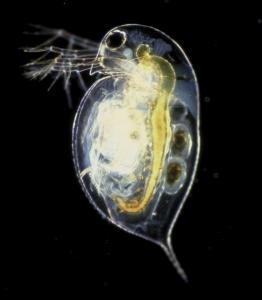Zig rigs are a popular type of rig, especially in the spring. Most articles and anglers generally attribute their success to carp sunning themselves near the surface in the newly warmed water. While carp may indeed be higher in the water column to raise their body temperatures, another reason is every bit as likely to account for their departure from bottom-feeding.
To better understand this phenomenon, we will first look at some basic aquatic ecology. There are two types of plankton found floating within the water of a lake: phytoplankton—microscopic plant like organisms, and zooplankton—tiny animals. These little organisms are what often give the water a greenish cast. Food availability within a lake is dependent on the nutrients found in the water. These nutrients are used by the phytoplankton which are then eaten by zooplankton. Zooplankton are eaten by all sorts of things, but most importantly for us they eventually end up feeding the carp.

Because phytoplankton need the sun to grow, during the winter when the light levels are low there aren’t too many of them around. This, in turn, means there are fewer zooplankton. Spring rolls around, and with it, more sunlight. Nutrients have accumulated all winter, and with this combination the plankton levels near the sunny surface skyrocket! These effects are particularly large in northern lakes, where ice and snows have made the water darker. Now there is an abundant food source in the lake that is off the bottom. The carp follow the food, and rise higher in the water column.

Now we know why the carp are there, but how can we use this knowledge to catch more fish? First, let’s talk bait size and flavor. It is well known that smaller zig rig baits are more effective than larger ones, and this makes sense considering the tiny size of the zooplankton. Because plankton don’t smell very strongly, the carp are locating them mainly by sight. If you are trying to closely “match the hatch”, it might be a good idea to stay away from flavored bait. Zooplankton are mostly clear or light colored, so for really picky fish and in clear water you might try to mimic them realistically using a light gray or off white bait. However, most of the time a high visibility zig rig is still the best, so pick bright yellow or white for daytime trips and black for evening/night for the highest contrast.

To locate the carp, remember our food web. Phytoplankton need high light levels, and so will be found no deeper than twice the depth that you can see a white object (this is approximately how deep light can penetrate). Zooplankton (and carp) will be nearby, so this is a good depth to start your search. In the evening the many plankton species will rise up higher in the water, so try fishing higher up during lower light conditions. Wind will also have some effect on the concentration of plankton. You should look for areas on the windward side of the lake where the current generated will concentrate the plankton.
Because a smaller bait is more realistic, you won’t be able to support a 6 foot leader off the bottom on the buoyancy of the bait alone, so a sliding type zig rig will be the best bet. I have seen a number of rigs that will do the job, but I have found that the ones with only the swivel of the lead to allow the rig to slide tend to jam with mud and weeds in most of the venues that I fish. A run ring rig similar to a marker float setup reduces this problem. Clear floats are popular for these rigs, and are supposed to give the rig a lower visibility. However, I am not sure that this will make a huge difference in waters where the carp are used to seeing all sorts of trash in the water, and/or when visibility is low.
Plankton are often overlooked as a food source by anglers, but carp will eat them when they are available. In fact, studies have shown that in the spring zooplankton make up the bulk of the carp’s diet! The plankton phenomenon, while most pronounced in the spring is by no means restricted to this season. There are reports of zigs working during all seasons, and this is at least partially due to the fact that zooplankton are available all year. While SCUBA diving during warmer months I have seen clouds of daphnia (a zooplankton that is often eaten by carp) in mid-water well off the bottom. A zig rig would be the only way of fishing in this zone, and would no doubt be effective. Taking the carps’ natural feeding habits into consideration when using a zig rig could mean the difference between a fish on the bank and blanking when faced with plankton feeding fish.

Nash zig bugs are available in the USA from big carp tackle: http://www.bigcarptackle.com/store/product.php?productid=20093&cat=0&page=1

